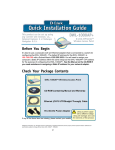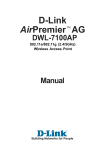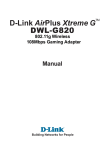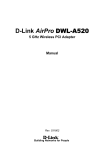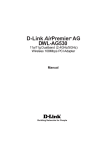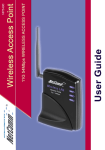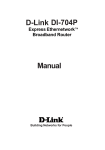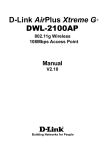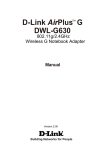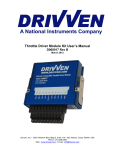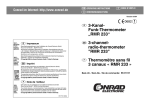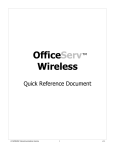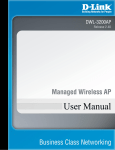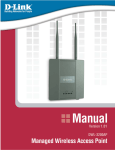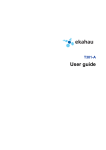Download D-Link AirPremier AG DWL-AG530 Installation guide
Transcript
D-Link AirPremier™ AG DWL-7100AP 802.11a/802.11g (2.4/5GHz) Wireless Access Point Manual Building Networks for People Contents Package Contents ................................................................................ 3 Introduction ........................................................................................... 4 Wireless Basics .................................................................................... 6 Installation Considerations ................................................................... 8 Getting Started ..................................................................................... 9 Using the Configuration Menu ............................................................ 11 Using the AP Manager ....................................................................... 31 Networking Basics .............................................................................. 51 Troubleshooting .................................................................................. 64 Technical Specifications ..................................................................... 70 Contacting Technical Support ............................................................. 72 Warranty ............................................................................................ 73 Registration ........................................................................................ 76 2 Package Contents Contents of Package: D-Link AirPremierTM AG DWL-7100AP 802.11a/802.11g (2.4GHz/5GHz) Wireless Access Point Power Adapter – 5V DC, 2.0A Manual on CD Quick Installation Guide Ethernet Cable Note: Using a power supply with a different voltage than the one included with the DWL-7100AP will cause damage and void the warranty for this product. If any of the above items are missing, please contact your reseller. System Requirements For Configuration: Computer with Windows, Macintosh, or Linux-based operating system with an installed Ethernet adapter Internet Explorer or Netscape Navigator version 6.0 or above, with JavaScript enabled At least 128MB of memory and a 500MHz processor 3 Introduction At up to fifteen times the speed of previous wireless devices (up to 108Mbps* in Super AG mode), you can work faster and more efficiently, increasing productivity. With the DWL-7100AP, bandwidth-intensive applications like graphics or multimedia will benefit significantly because large files are able to move across the network quickly. Inclusion of all three standards (802.11g; 802.11a; 802.11b) means that the DWL-7100AP is versatile enough to allow connection to almost any 802.11 network or device. The DWL-7100AP has the newest, strongest and most advanced security features available today. When used with other 802.11 WPA (Wi-Fi Protected Access) compatible products in a network with a RADIUS server, the security features include: WPA: Wi-Fi Protected Access which authorizes and identifies users based on a secret key that changes automatically at regular intervals. WPA uses TKIP (Temporal Key Integrity Protocol) to change the temporal key every 10,000 packets (a packet is a kind of message transmitted over a network.) This ensures much greater security than the standard WEP security. (By contrast, the previous WEP encryption implementations required the keys to be changed manually.) For home users that will not incorporate a RADIUS server in their network, the security for the DWL-7100AP, used in conjunction with other WPA-compatible 802.11 products, will still be much stronger than ever before. Utilizing the Pre-Shared Key mode of WPA, the DWL-7100AP will obtain a new security key every time it connects to the 802.11 network. You only need to input your encryption information once in the configuration menu. No longer will you have to manually input a new WEP key frequently to ensure security. With the DWL-7100AP, you will automatically receive a new key every time you connect, vastly increasing the safety of your communication. *“Maximum wireless signal rate derived from IEEE Standard 802.11a and 80211g specifications. Actual data throughput will vary. Network conditions and environmental factors, including volume of network traffic, building materials and construction, and network overhead lower actual data throughput rate.” 4 Features Faster Wireless Networking with speeds up to 108Mbps* in Super AG mode Compatible with 802.11a, 802.11b and 802.11g Devices - Fully compatible with the IEEE 802.11a, 802.11b and 802.11g standards, the DWL-7100AP can connect with existing 802.11b-, 802.11g- or 802.11a- compliant wireless network adapter cards. Better security with WPA- The DWL-7100AP can securely connect to wireless clients on the network using WPA (Wi-Fi Protected Access) providing a much higher level of security for your data and communications than has previously been available. LEDs LED stands for Light-Emitting Diode. The DWL-7100AP Wireless Access Point has 5 Green LEDs as shown below: LED LED Activity Power A steady light indicates a connection to a power source LAN (10/100) A steady light indicates a connection to the Ethernet port; a blinking light indicates activity WLAN (802.11a and 802.11b or 802.11g) A blinking light indicates activity in the respective wireless mode: 802.11a and/or 802.11b/802.11g *“Maximum wireless signal rate derived from IEEE Standard 802.11a and 80211g specifications. Actual data throughput will vary. Network conditions and environmental factors, including volume of network traffic, building materials and construction, and network overhead lower actual data throughput rate.” 5 Wireless Basics D-Link AirPremierTM AG wireless products are based on industry standards to provide easy-to-use and compatible high-speed wireless connectivity within your home, business or public access wireless networks. Strictly adhering to the IEEE standard, the D-Link AirPremierTM AG wireless family of products will allow you to securely access the data you want, when and where you want it. You will be able to enjoy the freedom that wireless networking delivers. A wireless local area network (WLAN) is a cellular computer network that transmits and receives data with radio signals instead of wires. Wireless LANs are used increasingly in both home and office environments, and public areas such as airports, coffee shops and universities. Innovative ways to utilize WLAN technology are helping people to work and communicate more efficiently. Increased mobility and the absence of cabling and other fixed infrastructure have proven to be beneficial for many users. Wireless users can use the same applications they use on a wired network. Wireless adapter cards used on laptop and desktop systems support the same protocols as Ethernet adapter cards. People use wireless LAN technology for many different purposes: Mobility - Productivity increases when people have access to data in any location within the operating range of the WLAN. Management decisions based on real-time information can significantly improve worker efficiency. Low Implementation Costs - WLANs are easy to set up, manage, change and relocate. Networks that frequently change can benefit from WLANs ease of implementation. WLANs can operate in locations where installation of wiring may be impractical. Installation and Network Expansion - Installing a WLAN system can be fast and easy and can eliminate the need to pull cable through walls and ceilings. Wireless technology allows the network to go where wires cannot go - even outside the home or office. Inexpensive Solution - Wireless network devices are as competitively priced as conventional Ethernet network devices. Scalability - WLANs can be configured in a variety of ways to meet the needs of specific applications and installations. Configurations are easily changed and range from Peer-to-Peer networks suitable for a small number of users to larger infrastructure networks to accommodate hundreds or thousands of users, depending on the number of wireless devices deployed. 6 Wireless Basics (continued) Standards-Based Technology The DWL-7100AP Wireless Access Point utilizes the 802.11a, 802.11b and draft 802.11g standard. The IEEE 802.11g standard is an extension of the 802.11b standard. It increases the data rate up to 54Mbps* within the 2.4GHz band. The 802.11a standard also increases the data rate up to 54Mbps, but within the 5GHz band. Both 802.11a and 802.11g utilize OFDM technology. This means that in most environments, within the specified range of this device, you will be able to transfer large files quickly or even watch a movie in MPEG format over your network without noticeable delays. This technology works by transmitting high-speed digital data over a radio wave utilizing OFDM (Orthogonal Frequency Division Multiplexing) technology. OFDM works by splitting the radio signal into multiple smaller sub-signals that are then transmitted simultaneously at different frequencies to the receiver. OFDM reduces the amount of crosstalk (interference) in signal transmissions. The DWL-7100AP offers the most advanced network security features available today, including WPA. In addition to its compatibility with 802.11g and 802.11a devices, the DWL-7100AP is backward compatible with 802.11b devices. This means that if you have an existing 802.11b network, or a network with a mixture of 802.11g, 802.11a and 802.11b, the devices in that network will be compatible with the DWL-7100AP. *“Maximum wireless signal rate derived from IEEE Standard 802.11a and 80211g specifications. Actual data throughput will vary. Network conditions and environmental factors, including volume of network traffic, building materials and construction, and network overhead lower actual data throughput rate.” 7 Wireless Basics (continued) Installation Considerations Desktop and laptop computers with wireless network adapters installed can access the D-Link AirPremierTM AG DWL-7100AP from virtually anywhere within its operating range. Keep in mind, however, that the number, thickness and location of walls, ceilings, or other objects that the wireless signals must pass through, may limit the range. Typical ranges vary depending on the types of materials and background RF (radio frequency) noise in your home or business. The key to maximizing wireless range is to follow these basic guidelines: 1 Keep the number of walls and ceilings between the DWL-7100AP and other network devices to a minimum - each wall or ceiling can reduce your D-Link wireless product’s range from 3-90 feet (1-30 meters.) Position your devices so that the number of walls or ceilings is minimized. 2 Be aware of the direct line between network devices. A wall that is 1.5 feet thick (.5 meters), at a 45-degree angle appears to be almost 3 feet (1 meter) thick. At a 2-degree angle it looks over 42 feet (14 meters) thick! Position devices so that the signal will travel straight through a wall or ceiling (instead of at an angle) for better reception. 3 Building materials can impede the wireless signal - a solid metal door or aluminum studs may have a negative effect on range. Try to position wireless devices and computers with wireless adapters so that the signal passes through drywall or open doorways and not other materials. 4 Keep your product away (at least 3-6 feet or 1-2 meters) from electrical devices or appliances that may generate extreme RF noise. 8 Getting Started Right out of the box, with its default settings, the DWL-7100AP will automatically connect with other D-Link AirPremierTM AG products. IP ADDRESS Note: If you are using a DHCP-capable router in your network you will not need to assign a static IP address. If you need to assign IP addresses to the computers on the network, please remember that the IP address for each computer must be in the same IP address range as all the computers in the network, and the subnet mask must be exactly the same for all the computers in the network. For example: If the first computer is assigned an IP address of 192.168.0.2 with a subnet mask of 255.255.255.0, then the second computer can be assigned an IP address of 192.168.0.3 with a subnet mask of 255.255.255.0, etc. IMPORTANT: If computers or other devices are assigned the same IP address, one or more of the devices may not be visible on the network. An Infrastructure wireless network contains a wireless access point or router. The Infrastructure Network example, shown on the following page, contains the following D-Link network devices: A wireless Access Point - D-Link AirPremierTM AG DWL-7100AP An Ethernet Router - D-Link DI-604 A laptop computer with a wireless adapter - D-Link AirPremierTM AG DWL-AG660 A desktop computer with a wireless adapter - D-Link AirPremierTMAG DWL-AG530 A Cable modem - D-Link DCM-201 9 Getting Started (continued) An Infrastructure wireless network contains an access point or router. The Infrastructure Network example, shown here, contains the following D-Link network devices: 1 2 Ethernet Router 3 DWL-7100AP 4 DWL-AG660 5 6 DWL-AG530 For a typical wireless setup (as shown above,) please do the following: You will need a broadband Internet access (Cable/DSL) subscription Consult with your Cable/DSL provider for proper installation of the modem Connect the modem to an Ethernet broadband router such as the DI-604. (See the Quick Installation Guide included with the DI-604.) Connect the router to the D-Link AirPremierTM AG DWL-7100AP. (See the Quick Installation Guide included with the DWL-7100AP.) If you are connecting a desktop computer in your network, you can install the D-Link AirPremierTM AG DWL-AG530 wireless PCI adapter into an available PCI slot. (See the Quick Installation Guide included with the DWL-AG530.) Install the drivers for the D-Link AirPremierTM AG DWL-AG660 into the laptop computer. (See the Quick Installation Guide included with the DWL-AG660.) 10 Using the Configuration Menu Whenever you want to configure your network or the DWL-7100AP, you can access the Configuration Menu by opening the web-browser and typing in the IP address of the DWL-7100AP. The DWL-7100AP default IP address is shown below: Open the web browser Type in the IP address of the access point Note: if you have changed the default IP address assigned to the DWL-7100AP, make sure to enter the correct IP address. Type admin in the User Name field Leave the Password blank Click Next Home > Wizard The Home>Wizard screen will appear. Please refer to the Quick Installation Guide for more information regarding the Setup Wizard. 11 Using the Configuration Menu (continued) Home > Wireless Note: In the Configuration screens that follow, you will be able to configure settings for 802.11a and 802.11g devices in your network. Settings that you input for 802.11g devices will also apply to 802.11b devices in your network. Wireless BandSSID- Select 802.11g or 802.11a from the pulldown menu. Service Set Identifier (SSID) is the name designated for a specific wireless local area network (WLAN). The SSID’s factory default setting is default. The SSID can be easily changed to connect to an existing wireless network or to establish a new wireless network. SSID Broadcast- Enable or Disable SSID Broadcast. Enabling this feature broadcasts the SSID across the network. ChannelRadio FrequencyApply- 52 is the default channel for 802.11a, and 6 is the default channel for 802.11g. All devices on the network must share the same channel. The radio frequency will reflect the channel selection. Click Apply to save the changes. 12 Using the Configuration Menu (continued) Home > LAN LAN is short for Local Area Network. This is considered your internal network. These are the IP settings of the LAN interface for the DWL-7100AP. These settings may be referred to as private settings. You may change the LAN IP address if needed. The LAN IP address is private to your internal network and cannot be seen on the Internet. Get IP From- Select Static (Manual) or Dynamic (DHCP) as the method you will use to assign an IP address to the DWL-7100AP. IP Address- The IP address of the LAN interface. The default IP address is: 192.168.0.50 (Note: You will need to use the AP Manager to determine the IP address dynamically assigned to the access point.) Subnet Mask- The default subnet mask is 255.255.255.0 Default Gateway- This field is optional. Enter in the lP address of the router on your network. Apply- Click Apply if you have made any changes. 13 Using the Configuration Menu (continued) Advanced > Mode Choose 802.11a or 802.11g wireless band; then select from the following options: Access Point: Select this mode to create a WLAN (wireless local area network). PtP Bridge (Point to Point Bridge): This mode enables you to connect two WLANS. Remote AP MAC Address: Input the remote AP MAC address of the AP with which the DWL-7100AP will associate. PtMP Bridge (Point to MultiPoint Bridge): This mode enables you to connect multiple WLANs Remote AP MAC Address: Input the remote AP MAC Addresses of the APs with which the DWL-7100AP will associate FOR INFORMATION REGARDING CONFIGURATION OF THE AP REPEATER AND AP CLIENT MODE, PLEASE SEE THE FOLLOWING PAGE OF THIS MANUAL. 14 Using the Configuration Menu (continued) Advanced > Mode > AP Repeater & AP Client When you select AP Repeater or AP Client mode, the Site Survey tool will appear as shown below. Double-click on the SSID of the network of your choice to automatically input the values for both the Root AP MAC Address and the SSID. AP Repeater: To extend the range of the wireless network select this option and enter the MAC address of the remote AP within your network that will have its range extended. (Use the Site Survey tool, as described above.) Root AP MAC Address: Enter the MAC address of the remote AP within your network that will have its range extended. (Use the Site Survey tool, as described above.) SSID: Enter the SSID that identifies the network. (Use the Site Survey tool, as described above.) AP Client: will transform any IEEE802.3 Ethernet device (e.g., a computer, printer, etc.) into an 802.11a or 802.11g wireless client when it communicates with another DWL-7100AP that is acting as an AP. Click to enable and enter the MAC address of the DWL-7100AP that is acting as the AP. (Use the Site Survey tool, as described above.) Root AP MAC Address: Enter the MAC address of the DWL-7100AP that is acting as an access point.(Use the Site Survey tool, as described above.) Apply: Click Apply if you have made any changes. 15 Using the Configuration Menu (continued) Wireless Band: Select 802.11a (up to 108Mbps speed in turbo mode in the 5GHz range) or 802.11g (up to 108Mbps speed in turbo mode in the 2.4GHz range) Advanced > Performance Frequency: The frequency will reflect the channel selection. Channel: The default channel for 802.11a is 52. The default channel for 802.11g is 6. Auto Channel Select: Select Enabled to enable the automatic selection of the most advantageous channel for use within your network. Data Rate: Select the transmission rate for the network Beacon Interval: Beacons are packets sent by an access point to synchronize a wireless network. Specify a Beacon interval value (20-1000.) Default (100) is recommended. DTIM: (Delivery Traffic Indication Message) Enter a value between 1 and 255 for the Delivery Traffic Indication Message (DTIM.) A DTIM is a countdown informing clients of the next window for listening to broadcast and multicast messages. Fragment Length: This value should remain at its default setting of 2346. If you experience a high packet error rate, you may slightly increase your Fragmentation Threshold within the value range of 256 to 2346. Setting the Fragmentation Threshold too low may result in poor performance. RTS Length: This value should remain at its default setting of 2346. If you encounter inconsistent data flow, only minor modifications to the value range between 256 and 2346 are recommended. Transmit Power: Adjust the transmission range here. This tool can be helpful for security purposes if you wish to limit the transmission range. 16 Using the Configuration Menu (continued) Advanced > Performance (continued) Super Mode: Super Mode is available in both 802.11a and 802.11g, as follows: Radio Wave: Select ON or OFF. Apply: Click Apply if you have made any changes. 17 Using the Configuration Menu (continued) Advanced > Filters > Wireless Access Settings Wireless Band: IEEE 802.11a is selected here. You can select 802.11a or 802.11g. Access Control: Disabled Accept Reject - Disable the Access Control feature Accept the MAC addresses in the list into the network Reject the MAC addresses in the list from participating in the network MAC Address: Input the MAC address. Click Save to include in the MAC address list below. MAC Address (Media Access Control Address) A unique hardware address that identifies a device on a network. It is assigned at the factory and cannot be changed. Usually you will find this address on a sticker on the device or on the packaging. (Please use the following format when entering the MAC address- xx:xx:xx:xx:xx:xx) 18 Using the Configuration Menu (continued) Advanced > Filters > WLAN Partition Wireless Band- Select IEEE802.11a or IEEE802.11g. Internal Station Connection- Enabling this feature allows wireless clients to communicate with each other. If this feature is disabled, wireless stations of the selected band are not allowed to exchange data through the access point. Ethernet to WLAN Access- Enabling this feature allows Ethernet devices to communicate with wireless clients. If this feature is disabled, all data from the Ethernet to associated wireless devices is blocked, but wireless devices can still send data to the Ethernet. Internal Station Connection Between 802.11a and 802.11g- Select Connection Enabled to enable communication between the 802.11a and the 802.11g bands. 19 Using the Configuration Menu (continued) Advanced > Encryption Wireless Band- Select IEEE 802.11g or IEEE 802.11a. 802.11a is selected here. Authentication- Select Open System to communicate the key across the network. Select Shared Key to limit communication to only those devices that share the same WEP settings. Select Open System/Shared Key to allow either form of data encryption. Select WPA-EAP to communicate using WPA encryption (with the use of a RADIUS server). Select WPA-PSK to communicate using WPA encryption (without the use of a RADIUS server). 20 Using the Configuration Menu (continued) Advanced > Encryption (continued) WPA mode- PSK - The Pre-Shared Key mode of WPA does not require the inclusion of a RADIUS server in your network. EAP - Extensible Authentication Protocol is a general authentication protocol that is used in conjunction with a RADIUS server in the network. Passphrase- If you selected PSK you will need to enter a Passphrase in this field. Cipher Type- If you selected EAP you will need to select a Cipher (EAP) Type: Auto, AES, or TKIP. Group Key Update Interval- If you selected PSK you will need to enter a figure in this field. RADIUS Server- Enter the IP address of the RADIUS server. RADIUS Port- Enter the port on your AP dedicated to the RADIUS server. RADIUS Secret- Enter the secret phrase. Encryption- Select Disabled or Enabled. Key Type- Select HEX or ASCII. Key Size- Select 64-, 128-, 152-bits. Valid Key- Select the 1st through the 4th key to be the active key. Key Table- Input up to four keys for encryption. You will select one of these keys in the valid key field. Apply- Click Apply to save changes. 21 Using the Configuration Menu (continued) Advanced > Grouping Load Balance: Select Enabled or Disabled. When you Enable Load Balance you allow several DWL-7100APs to balance wireless network traffic and wireless clients among the DWL-7100APs in the network. Assign each access point a different non-overlapping channel (e.g., 1, 6, 11). User Limit: Set the User Limit in this field (0-64). Link Integrity: Select Enabled or Disabled. When Link Integrity is Enabled, whenever the Ethernet connection between the LAN and the AP is disconnected - then the wireless segment associated with the AP will also be disconnected from the AP. Ethernet Link Status: This field displays the Ethernet Link Status. Link Up indicates that there is an Ethernet LAN connection to the AP. Apply: Click Apply if you have made any changes. 22 Using the Configuration Menu (continued) Advanced > DHCP Server > Dynamic Pool Settings DHCP Server ControlEnable or Disable the DHCP function here. Dynamic Pool SettingsIP Assigned From Enter the starting IP address in the range. The Range of Pool (1-255)Enter the number (the quantity) of IP address in the range. SubMask- Enter the subnet mask here. Gateway- Enter the IP address of the router on the network. Wins- Windows Internet Naming Service is a system that determines the IP address of a network computer that has a dynamically assigned IP address. DNS- Enter the IP address of the DNS server. The DNS server translates domain names such as www.dlink.com into IP addresses. Domain Name- Enter the Domain Name of the DWL-7100AP. Lease Time- Select the Lease Time here The Lease Time is the period of time before the DHCP server will assign new IP addresses. Status- Turn the Dynamic Pool Settings ON or OFF here. 23 Using the Configuration Menu (continued) Advanced > DHCP Server > Static Pool Settings DHCP Server ControlEnable or Disable the DHCP function here. Static Pool SettingsAssigned IPEnter the static IP address of the device here. Assigned MAC AddressE n t e r t h e M AC address of the device here. SubMask- Enter the subnet mask here. Gateway- Enter the IP address of the router on the network. Wins- Windows Internet Naming Service is a system that determines the IP address of a network computer that has a dynamically assigned IP address. DNS- Enter the IP address of the DNS server. The DNS server translates domain names such as www.dlink.com into IP addresses. Domain Name- Enter the Domain Name of the DWL-7100AP. Status- Turn the Static Pool Settings ON or OFF here. Assigned Static PoolAfter you have input the Static Pool Settings for each device, click Apply and the profile will appear in this list at the bottom of the window. Apply- Click Apply to save the changes. 24 Using the Configuration Menu (continued) Advanced > DHCP Server > Current IP Mapping List This screen displays information about the current DHCP dynamic and static IP address pools. This information is available when you enable the DHCP function of the DWL-7100AP and assign dynamic and static IP address pools. Current DHCP Dynamic Pools-These are IP address pools to which the DHCP server function has assigned dynamic IP addresses. Binding MAC address- The MAC address of a device on the network that is within the DHCP dynamic IP address pool. Assigned IP address- The current corresponding DHCP-assigned dynamic IP address of the device. Lease Time- The length of time that the dynamic IP address will be valid. Current DHCP Static Pools- These are IP address pools to which the DHCP server function has assigned static IP addresses. Binding MAC address- The MAC address of a device on the network that is within the DHCP static IP address pool. Assigned IP address- The current corresponding DHCP-assigned static IP address of the device. 25 Using the Configuration Menu (continued) Tools > Admin User Name: The default User Name is admin. Old Password: To change your password, first enter the old password. New Password: Enter the new password. Confirm New Password: Re-enter the new password. Apply: To save changes, click Apply. Tools > System Apply Settings and Restart: If you have made any changes to the configuration settings, click Restart to apply the changes. Restore to Factory Default Settings: To return the DWL-7100AP to the factory default settings, click Restore. 26 Using the Configuration Menu (continued) Tools> Firmware Update File: Click on Browse to find the updated firmware file on your hard drive. (Before you browse your hard drive you will need to download the updated firmware from the D-Link Support website: http://support.dlink.com) After you find the updated firmware file on your hard drive, click OK. 27 Using the Configuration Menu (continued) Tools > Cfg File Update File- Browse for the configuration settings that you have saved to your hard drive. Click OK when you made your selection. Load Settings to the Local Hard DriveClick OK to load the selected settings. Tools > Misc. Telnet Settings StatusClick to Enable a Telnet session. TimeoutSelect a time period after which a session timeout will occur. 28 Using the Configuration Menu (continued) Status > Device Info This window displays the settings of the DWL-7100AP, as well as the firmware version and the MAC address. This window displays the network traffic statistics for both received and transmitted communications through the Ethernet port and wireless connections associated with the access point. You may select 802.11a or 802.11g statistics. Status > Stats 29 Using the Configuration Menu (continued) Status > Client Info Here you will find client information, including MAC address, wireless band, authentication mode, signal strength and power saving mode. Help The Help menu is displayed here. You can also click on Help in any window for additional information. 30 Using the AP Manager The AP Manager is a convenient tool to manage the configuration of your network from a central computer. With AP Manager there is no need to configure devices individually. To launch the AP Manager: • Go to the Start Menu • Select Programs • Select D-Link AirPremier AG AP Manager • Select DWL-7100AP Discovering Devices Click on this button to discover the devices available on the network. 31 Using the AP Manager (continued) Selecting Devices The AP Manager allows you to configure multiple devices all at once. To select a single device, simply click on the device you want to select. To select multiple devices, hold down the Ctrl key while clicking on each additional device. To select an entire list, hold the Shift key, click on the first AP on the list and then click on the last AP on the list. IP Configuration You can assign an IP address to an AP or assign IP addresses to multiple AP’s by clicking on this button after selecting the device(s). Select the AP that you want to assign an IP address to and click the IP button. Enter the IP address and IP netmask for the selected device and click OK. You can configure multiple AP’s with IP addresses all at once. Click on the IP button after you’ve selected all of the AP’s you want to assign an IP address. Enter the IP address you want to assign the first unit and the AP manager will automatically assign sequential IP addresses. 32 Using the AP Manager (continued) Device Configuration Click on this button to access the configuration properties of the selected device(s). The device configuration window allows you to configure settings but does not actually apply the settings to the device unless you click the Apply button. You can also save and load configuration files from this window. When you load a configuration file, you must click Apply if you want the settings to be applied to the selected device(s). The Check All button will select all configurable options. Any setting that has a checkmark next to it is applied to the device or saved to the configuration file. The Clear Checks button deselects all configurable options. This feature is useful if you only want to change a few settings. Deselect all items and only check the items that you want to modify. Refresh will revert to the actual device settings of the selected device(s). To save settings to the device, you must click the Apply button. Only settings that have a checkmark next to them will be applied. The open button is used to load a previously saved configuration file. After opening a configuration file, you must click the Apply button to save the settings to the selected device(s). The save button allows you to save a configuration file of the selected device settings. Only settings that have a checkmark next to them are saved. You cannot save a configuration file if you selected more than one device in the device list. The Exit button will close the device configuration window. Any settings that haven’t been applied will be lost. 33 Using the AP Manager (continued) Device Configuration>General When selecting multiple devices for configuration, some options are unavailable for configuration as noted(*) below: • Device Name(*): This allows you to change the device name for the selected access point. You must place a checkmark in the Device Name box to change the name. This option can only be configured when one access point is selected for configuration. • IP address and Subnet Mask(*): If you’ve selected one device for configuration and you want to change the IP address of the device, check the IP Address box. You can then enter an IP address and Subnet Mask for the selected access point. This option is only configurable when one access point is selected for configuration. To configure multiple devices with an IP address at one time, please reference the previous page. • Gateway: Enter the IP address of your gateway, typically your router address. • DHCP client: There is a pulldown menu to select enabled or disabled. When enabled, the selected device(s) will function as a DHCP client(s). This allows them to receive IP configuration information from a DHCP server. When disabled, the access point(s) must have a static IP address assigned to them. 34 Using the AP Manager (continued) Device Configuration>General (continued) • Load Balance: This pulldown selection enables or disables load balancing. When you enable load balance you allow several access points to balance wireless network traffic and wireless clients among the access points with the same SSID. All the APs that share Load Balancing must have the same SSID. Assign each access point a different non-overlapping channel (e.g., 1, 6, 11). User Limit: Enter the number of load balancing users, from 0-64. • Link Integrity: This pulldown selection enables or disables Link Integrity. When Link Integrity is enabled, the wireless segment associated with the AP will be disconnected whenever the connection between the AP and the LAN is dropped. • Telnet Support: This pulldown selection enables or disables the ability to Telnet into the selected device(s). • Telnet Timeout: This pulldown selection defines the timeout period during a Telnet session with the selected device(s). 35 Using the AP Manager (continued) Device Configuration>Wireless>IEEE802.11a • SSID: The Service Set (network) • Channel: Allows you to select a channel. 52 is the default setting. • SSID Broadcast: Allows you to enable or disable the broadcasting of the SSID to network clients. • Super A: Super A is a group of performance enhancement features that increase end user application throughput in an 802.11a network. Super A is backwards compatible with standard 802.11a devices. For ideal performance, all wireless devices on the network should be Super A capable. The modes are listed below: Identifier of your wireless network. • Radio Wave: Enable or disable the wireless functionality of the selected device(s). • Data Rate: A pulldown menu to select the maximum wireless signal rate for the selected devices(s). • Beacon Interval (20~1000): Beacons are packets sent by an access point to synchronize a network. Specify the beacon value for the selected device(s) here. The default value of 100 is recommended. • DTIM (1~255): DTIM (Delivery Traffic Indication Message) is a countdown informing clients of the next listening window for broadcast and multicast messages. • Fragment Length (256~2346): This sets the fragmentation threshold (specified in bytes). Packets exceeding the value set here will be fragmented. The default is 2346. • RTS Length (256~2346): The RTS value should not be changed unless you encounter inconsistent data flow. The default value is 2346. • Tx Power: A pulldown menu for selecting the transmit power of the selected device(s). • Auto Channel Scan: Enable to scan for the least populated channel. 36 Using the AP Manager (continued) Device Configuration>Wireless • SSID: The Service Set (network) Identifier of your wireless network. • Channel: Allows you to select a channel. 6 is the default setting. • SSID Broadcast: Allows you to enable or disable the broadcasting of the SSID to network clients. • Super G: Super G is a group of performance enhancement features that increase end user application throughput in an 802.11g network. Super G is backwards compatible with standard 802.11g devices. For ideal performance, all wireless devices on the network should be Super G capable. The modes are listed below: • Radio Wave: Enable or disable the wireless functionality of the selected device(s). • Data Rate: A pulldown menu to select the maximum wireless signal rate for the selected devices(s). • Beacon Interval (20~1000): Beacons are packets sent by an access point to synchronize a network. Specify the beacon value for the selected device(s) here. The default value of 100 is recommended. • DTIM (1~255): DTIM (Delivery Traffic Indication Message) is a countdown informing clients of the next listening window for broadcast and multicast messages. • Fragment Length (256~2346): This sets the fragmentation threshold (specified in bytes). Packets exceeding the value set here will be fragmented. The default is 2346. • RTS Length (256~2346): The RTS value should not be changed unless you encounter inconsistent data flow. The default value is 2346. • Tx Power: A pulldown menu for selecting the transmit power of the selected device(s). • Auto Channel Scan: Enable to scan for the least populated channel. 37 Using the AP Manager (continued) Device Configuration>Security>IEEE802.11a & IEEE802.11g The Security tab contains the WEP configuration settings on the intial page. If you select WPA as the authentication type, an additional tab will appear with the WPA configuration options based on your selection. • Authentication Type: Select from the pulldown menu the type of authentication to be used on the selected device(s). • Encryption: Enable or disable encryption on the selected device(s). • Active Key Index: Select which defined key is active on the selected device(s). • Key Values: Select the key size (64-bit, 128-bit, or 152-bit) and key type (HEX or ASCII) and then enter a string to use as the key. The key length is automatically adjusted based on the settings you choose. 38 Using the AP Manager (continued) Device Configuration>Security>IEEE 802.11a>WPA-EAP • Cipher Type: Select Auto, TKIP, or AES from the pulldown menu. • Group Key Update Interval: Select the interval during which the group key will be vaild. 1800 is the recommended setting. A lower interval may reduce transfer rates. Device Configuration>Security>IEEE 802.11g>WPA-EAP • Cipher Type: Select Auto, TKIP, or AES from the pulldown menu. • Group Key Update Interval: Select the interval during which the group key will be vaild. 1800 is the recommended setting. A lower interval may reduce transfer rates. 39 Using the AP Manager (continued) Device Configuration>Security> IEEE 802.11a & IEEE 802.11g>Security Server • RADIUS Server: Enter the IP address of the RADIUS server. • RADIUS Port: Enter the port used on the RADIUS server. • RADIUS Secret: Enter the RADIUS secret. Device Configuration>Security>WPA-PSK • Cipher Type: Select auto, TKIP, or AES from the pulldown menu. • Group Key Update Interval: Select the interval during which the group key will be vaild. 1800 is the recommended setting. A lower interval may reduce transfer rates. • P a s s P h r a s e: E n t e r a PassPhrase between 863 characters in length . 40 Using the AP Manager (continued) Device Configuration>Filters • Internal Station Connect Cross 11a, 11g: Enabling this allows wireless IEEE802.11a and IEEE802.11g clients to communicate with each other. When this option is disabled, IEEE802.11a and IEEE802.11g wireless stations are not allowed to exchange data through the access point. The following features are configurable in IEEE802.11a & IEEE802.11g: • Internal Station Connection: Enabling this allows wireless clients to communicate with each other. When this option is disabled, wireless stations are not allowed to exchange data through the access point. • Broadcast from Ethernet to WLAN: Enabling this option allows Ethernet devices to communicate with wireless clients. When this option is disabled, all data from Ethernet to wireless clients is blocked. Wireless devices can still send data to the Ethernet devices when this is disabled. • Access Control: When disabled access control is not filtered based on the MAC address. If Accept or Reject is selected, then a box appears for entering MAC addresses. When Accept is selected, only devices with a MAC address in the list are granted access. When Reject is selected, devices in the list of MAC addresses are not granted access. • ACL MAC Address: To add to the Access Control List (ACL), enter the MAC address and click Add. To delete a MAC address, highlight it and press Del. 41 Using the AP Manager (continued) Device Configuration>AP Mode The following featuresare configurable in IEEE802.11a & IEEE802.11g: • Access Point: The default setting used to create a wireless LAN. • PtP Bridge: Allows you to connect two wireless LANs together. This only works with another DWL-7100AP. If enabled you must enter the MAC address of the other DWL-7100AP. • PtMP Bridge: Allows you to connect mulitple wireless LANs together. All other LANs must be using DWL-7100APs. When enabled, you must enter the MAC address of the other DWL-7100APs. Enter up to eight addresses. • AP Repeater: Allows you to repeat the wireless signal of the root access point. When enabled you must enter the MAC address of the root access point. • AP Client: Allows any device with an Ethernet connection to connect to the wireless network via another DWL-7100AP, such as a printer, gaming console (Xbox, PS2), or a computer. You will need to enter the SSID of the DWL-7100AP that is functioning as an AP. 42 Using the AP Manager (continued) Device Configuration>DHCP • DHCP Server: Enable or disable the DHCP server function. • Dynamic Pool Settings: Click to enable Dynamic Pool Settings. Configure the IP address pool in the fields below. • Static Pool Settings: Click to enable Static Pool Settings. Use this function to assign the same IP address to a device at every restart. The IP addresses assigned in the Static Pool list must NOT be in the same IP range as the Dynamic Pool. • IP Assigned From: Enter the initial IP address to be assigned by the DHCP server. • Range of Pool (1~255): Enter the number of allocated IP addresses. • SubMask: Enter the subnet mask. • Gateway: Enter the gateway IP address, typically a router. • Wins: Wins (Windows Internet Naming Service) is a system that determines the IP address of a network computer with a dynamically assigned IP address, if applicable. • DNS: The IP address of the DNS server, if applicable. • Domain Name: Enter the domain name of the DWL-7100AP, if applicable. • Lease Time: The period of time that the client will retain the assigned IP address. • Status: This option turns the dynamic pool settings on or off. 43 Using the AP Manager (continued) Configuration Files The DWL-7100AP allows you to save the device settings to a configuration file. To save a configuration file, follow these steps: • Select a device from the Device List on the main screen of the AP Manager. • Click the device configuration button. • Click the Save button after you have all of the settings as you want them. • A popup window will appear prompting you for a file name and location. Enter the file name, choose a file destination, and click Save. Device Configuration button. To load a previously saved configuration file, follow these steps: • Select a device or devices from the Device List on the main screen of the AP Manager. • Click the device configuration button. • Click the Open button. • A popup window will appear prompting you to locate the configuration file. Locate the file and click Open. • The configuration file is loaded into the AP Manager but has not actually been written to the device(s). If you want to use the newly loaded configuration for the selected device(s), click Apply and the configuration settings will be written to the device(s). Device Configuration button. You must always click Apply in the Configuration window if you want the settings to take effect. 44 Using the AP Manager (continued) Firmware You can upgrade the firmware by clicking on this button after selecting the device(s). To upgrade the firmware: • Download the latest firmware upgrade from http://support.dlink.com to an easy to find location on your hard drive. • Click on the firmware button as shown above. • A popup window will appear. Locate the firmware upgrade file and click Open. IMPORTANT! DO NOT DISCONNECT POWER FROM THE UNIT WHILE THE FIRMWARE IS BEING UPGRADED. System Settings You can customize the basic System Settings for the DWL-7100AP by clicking on this button. • Access Password: This sets the admin password for the selected device(s). • Auto Refresh: This setting allows you to enable auto refreshing of the network device list. By default this option is disabled. If you choose to enable it, you must enter the refresh interval in seconds. All other settings on this screen should be left at the default setting. 45 Using the AP Manager (continued) Setup Wizard This button will launch the Setup Wizard that will guide you through device configuration. Click Next Enter a Password and retype it in the Verify Password field. Click Next 46 Using the AP Manager (continued) Setup Wizard (continued) IEEE802.11g Enter the SSID and the Channel for the network. Click Next If you want to enable Encryption, enter the Encryption values here. Click Next 47 Using the AP Manager (continued) Setup Wizard (continued) IEEE802.11a Enter the SSID and the Channel for the network. Click Next If you want to enable Encryption, enter the Encryption values here. Click Next 48 Using the AP Manager (continued) Setup Wizard (continued) Click Finish The DWL-7100AP setup is complete! 49 Using the AP Manager (continued) Refresh Click on this button to refresh the list of devices available on the network. Devices with a checkmark next to them are still available on the network. Devices with an X are no longer available on the network. About Click on this button to view the version of AP Manager. 50 Networking Basics Using the Network Setup Wizard in Windows XP In this section you will learn how to establish a network at home or work, using Microsoft Windows XP. Note: Please refer to websites such as http://www.homenethelp.com and http://www.microsoft.com/windows2000 for information about networking computers using Windows 2000. Go to Start>Control Panel>Network Connections Select Set up a home or small office network When this screen appears, click Next. 51 Networking Basics (continued) Please follow all the instructions in this window: Click Next. In the following window, select the best description of your computer. If your computer connects to the internet through a gateway/router, select the second option as shown. Click Next. 52 Networking Basics (continued) Enter a Computer description and a Computer name (optional.) Click Next. Enter a Workgroup name. All computers on your network should have the same Workgroup name. Click Next. 53 Networking Basics (continued) Please wait while the Network Setup Wizard applies the changes. When the changes are complete, click Next. Please wait while the Network Setup Wizard configures the computer. This may take a few minutes. 54 Networking Basics (continued) In the window below, select the option that fits your needs. In this example, Create a Network Setup Disk has been selected. You will run this disk on each of the computers on your network. Click Next. Insert a disk into the Floppy Disk Drive, in this case drive A. Format the disk if you wish, and click Next. 55 Networking Basics (continued) Please wait while the Network Setup Wizard copies the files. Please read the information under Here’s how in the screen below. After you complete the Network Setup Wizard you will use the Network Setup Disk to run the Network Setup Wizard once on each of the computers on your network.To continue click Next. 56 Networking Basics (continued) Please read the information on this screen, then click Finish to complete the Network Setup Wizard. The new settings will take effect when you restart the computer. Click Yes to restart the computer. You have completed configuring this computer. Next, you will need to run the Network Setup Disk on all the other computers on your network. After running the Network Setup Disk on all your computers, your new wireless network will be ready to use. 57 Networking Basics (continued) Naming your Computer To name your computer in Windows XP, please follow these directions: Click Start (in the lower left corner of the screen). Right-click on My Computer. Select Properties. Select the Computer Name Tab in the System Properties window. You may enter a Computer Description if you wish; this field is optional. To rename the computer and join a domain, click Change. 58 Networking Basics (continued) Naming your Computer In this window, enter the Computer name. Select Workgroup and enter the name of the Workgroup. All computers on your network must have the same Workgroup name. Click OK. Checking the IP Address in Windows XP The wireless adapter-equipped computers in your network must be in the same IP address range (see Getting Started in this manual for a definition of IP address range). To check on the IP address of the adapter, please do the following: Right-click on the Local Area Connection icon in the task bar. Click on Status. 59 Networking Basics (continued) Checking the IP Address in Windows XP This window will appear. Click the Support tab. Click Close. Assigning a Static IP Address in Windows XP/2000 Note: DHCP-capable routers will automatically assign IP addresses to the computers on the network, using DHCP (Dynamic Host Configuration Protocol) technology. If you are using a DHCP-capable router you will not need to assign static IP addresses. If you are not using a DHCP capable router, or you need to assign a static IP address, please follow these instructions: Go to Start. Click on Control Panel. 60 Networking Basics (continued) Assigning a Static IP Address in Windows XP/2000 Double-click on Network Connections. Right-click on Local Area Connections. Click on Properties. 61 Networking Basics (continued) Assigning a Static IP Address in Windows XP/2000 Click on Internet Protocol (TCP/IP) Click Properties In the window below, select Use the following IP address. Input your IP address and subnet mask. (The IP addresses on your network must be within the same range. For example, if one computer has an IP address of 192.168.0.2, the other computers should have IP addresses that are sequential, like 192.168.0.3 and 192.168.0.4. The subnet mask must be the same for all the computers on the network). IP Address: e.g., 192.168.0.2 Subnet Mask: 255.255.255.0 Default Gateway: Enter the LAN IP address of the wireless router. (D-Link wireless routers have a LAN IP address of 192.168.0.1) Select Use the following DNS server addresses. Enter the LAN IP address of the wireless router. (D-Link wireless routers have a LAN IP address of 192.168.0.1) Click OK You have completed the assignment of a static IP address. (You do not need to assign a static IP address if you have a DHCP-capable router). 62 Networking Basics (continued) Checking the Wireless Connection by Pinging in Windows XP and 2000 Go to Start > Run > type cmd. A window similar to this one will appear. Type ping xxx.xxx.xxx.xxx, where xxx is the IP Address of the Wireless Router or Access Point. A good wireless connection will show four replies from the Wireless Router or Access Point, as shown. 63 Troubleshooting This Chapter provides solutions to problems that can occur during the installation and operation of the DWL-7100AP Wireless Access Point. We cover various aspects of the network setup, including the network adapters. Please read the following if you are having problems. Note: It is recommended that you use an Ethernet connection to configure the DWL-7100AP. 1. The computer used to configure the DWL-7100AP cannot access the Configuration menu. Check that the Ethernet LED on the DWL-7100AP is ON. If the LED is not ON, check that the cable for the Ethernet connection is securely inserted. Check that the Ethernet adapter is working properly. Please see item 3 in this section: Check that the drivers for the network adapters are installed properly. Check that the IP address is in the same range and subnet as the DWL-7100AP. Please see Checking the IP Address in Windows XP in the Networking Basics section of this manual. Note: The IP address of the DWL-7100AP is 192.168.0.50. All the computers on the network must have a unique IP address in the same range, e.g., 192.168.0.x. Any computers that have identical IP addresses will not be visible on the network. They must all have the same subnet mask, e.g., 255.255.255.0 Do a Ping test to make sure that the DWL-7100AP is responding. Go to Start>Run>Type Command>Type ping 192.168.0.50. A successful ping will show four replies. Note: If you have changed the default IP address, make sure to ping the correct IP address assigned to the DWL-7100AP. 64 Troubleshooting (continued) 2. The wireless client cannot access the Internet in the Infrastructure mode. Make sure the wireless client is associated and joined with the correct access point. To check this connection: Right-click on the Local Area Connection icon in the taskbar> select View Available Wireless Networks. The Connect to Wireless Network screen will appear. Please make sure you have selected the correct available network, as shown in the illustrations below. default Check that the IP address assigned to the wireless adapter is within the same IP address range as the access point and gateway. (Since the DWL7100AP has an IP address of 192.168.0.50, wireless adapters must have an IP address in the same range, e.g., 192.168.0.x. Each device must have a unique IP address; no two devices may have the same IP address. The subnet mask must be the same for all the computers on the network.) To check the IP address assigned to the wireless adapter, double-click on the local area connection icon in the taskbar > select the support tab and the IP address will be displayed. (Please refer to Checking the IP Address in the Networking Basics section of this manual.) If it is necessary to assign a static IP address to the wireless adapter, please refer to the appropriate section in Networking Basics. If you are entering a DNS server address you must also enter the default gateway address. (Remember that if you have a DHCP-capable router, you will not need to assign a static IP address. See Networking Basics: Assigning a Static IP Address.) 65 Troubleshooting (continued) 3. Check that the drivers for the network adapters are installed properly. You may be using different network adapters than those illustrated here, but this procedure will remain the same, regardless of the type of network adapters you are using. Go to Start Right-click on My Computer Click Properties Select the Hardware tab Click Device Manager 66 Troubleshooting (continued) Double-click on Network adapters Right-click on D-Link DWLA650 Wireless Cardbus Adapter Select Properties to check that the drivers are installed properly Look under Device status D-Link DWL-A650 to check that the device is working properly D-Link DWL-A650 Click OK 67 Troubleshooting (continued) 4. What variables may cause my wireless products to lose reception? D-Link products let you access your network from virtually anywhere you want. However, the positioning of the products within your environment will affect the wireless range. Please refer to Installation Considerations in the Wireless Basics section of this manual for further information about the most advantageous placement of your D-Link wireless products. 5. Why does my wireless connection keep dropping? Antenna orientation- Try different antenna orientations for the DWL-7100AP. Try to keep the antenna at least 6 inches away from the wall or other objects. If you are using 2.4GHz cordless phones, X-10 equipment or other home security systems, ceiling fans, and lights, your wireless connection will degrade dramatically or drop altogether. Try changing the channel on your access point and wireless adapter to a different channel to avoid interference. Keep your product away (at least 3-6 feet) from electrical devices that generate RF noise, like microwaves, monitors, electric motors, etc. 6. Why can’t I get a wireless connection? To establish a wireless connection, while enabling Encryption on the DWL-7100AP, you must also enable encryption on the wireless client. For 802.11a, the Encryption settings are: 64-, 128- or 152-bit. Make sure that the encryption bit level is the same on the access point and the wireless client. For 802.11b, the Encryption settings are: 64-, 128-, or 256-bit. Make sure that the encryption bit level is the same on the access point and the wireless client. Make sure that the SSID on the access point and the wireless client are exactly the same. If they are not, wireless connection will not be established. Please note that there are two separate SSIDs for 802.11a and 802.11b. The default SSID for both 802.11a and 802.11b is default. 68 Troubleshooting (continued) 7. Resetting the DWL-7100AP to Factory Default Settings After you have tried other methods for troubleshooting your network, you may choose to Reset the DWL-7100AP to the factory default settings. To hard-reset the D-Link DWL-7100AP to factory default settings, please do the following: Locate the Reset button on the back of the DWL-7100AP Use a paper clip to press the Reset button Hold for about 10 seconds and then release After the DWL-7100AP reboots (this may take a few minutes) it will be reset to the factory default settings 69 Technical Specifications Standards • IEEE 802.11a • IEEE 802.11b • IEEE 802.11g • IEEE 802.3 • IEEE 802.3u • IEEE 802.3x Device Management • Web-Based – Internet Explorer v6 or later; Netscape Navigator v6 or later; or other Java-enabled browsers. • Telnet • AP Manager • SNMP v.3 Security • 64-, 128-, 152-bit WEP • WPA – Wi-Fi Protected Access (WPA-TKIP and WPA-PSK) • 802.1x (EAP-MD5/TLS/TTLS/PEAP) • MAC Address Access Control List • Advanced Encryption Standard (AES-CCM) Wireless Frequency Range • 2.4GHz to 2.4835GHz • 5.15GHz to 5.35GHz and 5.725GHz to 5.825GHz Radio and Modulation Type For 802.11b: DSSS: • DBPSK @ 1Mbps • DQPSK @ 2Mbps • CCK @ 5.5 and 11Mbps For 802.11a/g: 70 Technical Specifications (continued) OFDM: • BPSK @ 6 and 9Mbps • QPSK @ 12 and 18Mbps • 16QAM @ 24 and 36Mbps • 64QAM @ 48 and 54Mbps DSSS: • DBPSK @ 1Mbps • DQPSK @ 2Mbps • CCK @ 5.5 and 11Mbps Receiver Sensitivity For 802.11a: • 6Mbps: -87dBm • 9Mbps: -86dBm • 11Mbps: -88dBm • 12Mbps: -85dBm • 18Mbps: -83dBm • 24Mbps: -80dBm • 36Mbps: -76dBm • 48Mbps: -71dBm • 54Mbps: -71dBm For 802.11b: • 1Mbps: -92dBm • 2Mbps: -89dBm • 5.5Mbps: -88dBm • 11Mbps: -83dBm For 802.11g: • 1Mbps: -95dBm • 2Mbps: -91dBm • 5.5Mbps: -89dBm • 6Mbps: -87dBm • 9Mbps: -85dBm • 11Mbps: -88dBm • 12Mbps: -80dBm • 18Mbps: -80dBm • 24Mbps: -77dBm • 36Mbps: -73dBm • 48Mbps: -72dBm • 54Mbps: -72dBm Transmit Output Power For 802.11a: • 63mW (18dBm) • 40mW (16dBm) • 32mW (15dBm) • 6mW (7dBm) • 1mW (0dBm) For 802.11b: • 63mW (18dBm) • 40mW (16dBm) • 32mW (15dBm) • 23mW (13dBm) • 10mW (10dBm) • 6mW (7dBm) • 1mW (0dBm) For 802.11g: • 63mW (18dBm) • 40mW (16dBm) • 32mW (15dBm) • 6mW (7dBm) 71 Technical Support You can find software updates and user documentation on the D-Link website. D-Link provides free technical support for customers within the United States and within Canada for the duration of the warranty period on this product. U.S. and Canadian customers can contact D-Link technical support through our website, or by phone. Tech Support for customers within the United States: D-Link Technical Support over the Telephone: (877) 453-5465 24 hours a day, seven days a week. D-Link Technical Support over the Internet: http://support.dlink.com email:[email protected] Tech Support for customers within Canada: D-Link Technical Support over the Telephone: (800) 361-5265 Monday to Friday 7:30am to 12:00am EST D-Link Technical Support over the Internet: http://support.dlink.ca email:[email protected] 72 Warranty (USA only) Subject to the terms and conditions set forth herein, D-Link Systems, Inc. (“D-Link”) provides this Limited warranty for its product only to the person or entity that originally purchased the product from: • D-Link or its authorized reseller or distributor and • Products purchased and delivered within the fifty states of the United States, the District of Columbia, U.S. Possessions or Protectorates, U.S. Military Installations, addresses with an APO or FPO. Limited Warranty: D-Link warrants that the hardware portion of the D-Link products described below will be free from material defects in workmanship and materials from the date of original retail purchase of the product, for the period set forth below applicable to the product type (“Warranty Period”), except as otherwise stated herein. 3-Year Limited Warranty for the Product(s) is defined as follows: • Hardware (excluding power supplies and fans) Three (3) Years • Power Supplies and Fans One (1) Year • Spare parts and spare kits Ninety (90) days D-Link’s sole obligation shall be to repair or replace the defective Hardware during the Warranty Period at no charge to the original owner or to refund at D-Link’s sole discretion. Such repair or replacement will be rendered by D-Link at an Authorized D-Link Service Office. The replacement Hardware need not be new or have an identical make, model or part. D-Link may in its sole discretion replace the defective Hardware (or any part thereof) with any reconditioned product that D-Link reasonably determines is substantially equivalent (or superior) in all material respects to the defective Hardware. Repaired or replacement Hardware will be warranted for the remainder of the original Warranty Period from the date of original retail purchase. If a material defect is incapable of correction, or if D-Link determines in its sole discretion that it is not practical to repair or replace the defective Hardware, the price paid by the original purchaser for the defective Hardware will be refunded by D-Link upon return to D-Link of the defective Hardware. All Hardware (or part thereof) that is replaced by D-Link, or for which the purchase price is refunded, shall become the property of D-Link upon replacement or refund. Limited Software Warranty: D-Link warrants that the software portion of the product (“Software”) will substantially conform to D-Link’s then current functional specifications for the Software, as set forth in the applicable documentation, from the date of original retail purchase of the Software for a period of ninety (90) days (“Warranty Period”), provided that the Software is properly installed on approved hardware and operated as contemplated in its documentation. D-Link further warrants that, during the Warranty Period, the magnetic media on which D-Link delivers the Software will be free of physical defects. D-Link’s sole obligation shall be to replace the non-conforming Software (or defective media) with software that substantially conforms to D-Link’s functional specifications for the Software or to refund at D-Link’s sole discretion. Except as otherwise agreed by D-Link in writing, the replacement Software is provided only to the original licensee, and is subject to the terms and conditions of the license granted by D-Link for the Software. Software will be warranted for the remainder of the original Warranty Period from the date or original retail purchase. If a material non-conformance is incapable of correction, or if D-Link determines in its sole discretion that it is not practical to replace the non-conforming Software, the price paid by the original licensee for the nonconforming Software will be refunded by D-Link; provided that the non-conforming Software (and all copies thereof) is first returned to D-Link. The license granted respecting any Software for which a refund is given automatically terminates. Non-Applicability of Warranty: The Limited Warranty provided hereunder for hardware and software of DLink’s products will not be applied to and does not cover any refurbished product and any product purchased through the inventory clearance or liquidation sale or other sales in which D-Link, the sellers, or the liquidators expressly disclaim their warranty obligation pertaining to the product and in that case, the product is being sold “As-Is” without any warranty whatsoever including, without limitation, the Limited Warranty as described herein, notwithstanding anything stated herein to the contrary. Submitting A Claim: The customer shall return the product to the original purchase point based on its return policy. In case the return policy period has expired and the product is within warranty, the customer shall submit a claim to D-Link as outlined below: 73 • The customer must submit with the product as part of the claim a written description of the Hardware defect or Software nonconformance in sufficient detail to allow D-Link to confirm the same. • The original product owner must obtain a Return Material Authorization (“RMA”) number from the Authorized D-Link Service Office and, if requested, provide written proof of purchase of the product (such as a copy of the dated purchase invoice for the product) before the warranty service is provided. • After an RMA number is issued, the defective product must be packaged securely in the original or other suitable shipping package to ensure that it will not be damaged in transit, and the RMA number must be prominently marked on the outside of the package. Do not include any manuals or accessories in the shipping package. D-Link will only replace the defective portion of the Product and will not ship back any accessories. • The customer is responsible for all in-bound shipping charges to D-Link. No Cash on Delivery (“COD”) is allowed. Products sent COD will either be rejected by D-Link or become the property of D-Link. Products shall be fully insured by the customer. D-Link will not be held responsible for any packages that are lost in transit to D-Link. The repaired or replaced packages will be shipped to the customer via UPS Ground or any common carrier selected by D-Link, with shipping charges prepaid. Expedited shipping is available if shipping charges are prepaid by the customer and upon request. • Return Merchandise Ship-To Address USA:17595 Mt. Herrmann, Fountain Valley, CA 92708-4160 Canada: 2180 Winston Park Drive, Oakville, ON, L6H 5W1 (Visit http://www.dlink.ca for detailed warranty information within Canada) D-Link may reject or return any product that is not packaged and shipped in strict compliance with the foregoing requirements, or for which an RMA number is not visible from the outside of the package. The product owner agrees to pay D-Link’s reasonable handling and return shipping charges for any product that is not packaged and shipped in accordance with the foregoing requirements, or that is determined by D-Link not to be defective or non-conforming. What Is Not Covered: This limited warranty provided by D-Link does not cover: Products, if in D-Link’s judgment, have been subjected to abuse, accident, alteration, modification, tampering, negligence, misuse, faulty installation, lack of reasonable care, repair or service in any way that is not contemplated in the documentation for the product, or if the model or serial number has been altered, tampered with, defaced or removed; Initial installation, installation and removal of the product for repair, and shipping costs; Operational adjustments covered in the operating manual for the product, and normal maintenance; Damage that occurs in shipment, due to act of God, failures due to power surge, and cosmetic damage; Any hardware, software, firmware or other products or services provided by anyone other than D-Link; Products that have been purchased from inventory clearance or liquidation sales or other sales in which D-Link, the sellers, or the liquidators expressly disclaim their warranty obligation pertaining to the product. Repair by anyone other than D-Link or an Authorized D-Link Service Office will void this Warranty. Disclaimer of Other Warranties: EXCEPT FOR THE LIMITED WARRANTY SPECIFIED HEREIN, THE PRODUCT IS PROVIDED “AS-IS” WITHOUT ANY WARRANTY OF ANY KIND WHATSOEVER INCLUDING, WITHOUT LIMITATION, ANY WARRANTY OF MERCHANTABILITY, FITNESS FOR A PARTICULAR PURPOSE AND NON-INFRINGEMENT. IF ANY IMPLIED WARRANTY CANNOT BE DISCLAIMED IN ANY TERRITORY WHERE A PRODUCT IS SOLD, THE DURATION OF SUCH IMPLIED WARRANTY SHALL BE LIMITED TO NINETY (90) DAYS. EXCEPT AS EXPRESSLY COVERED UNDER THE LIMITED WARRANTY PROVIDED HEREIN, THE ENTIRE RISK AS TO THE QUALITY, SELECTION AND PERFORMANCE OF THE PRODUCT IS WITH THE PURCHASER OF THE PRODUCT. Limitation of Liability: TO THE MAXIMUM EXTENT PERMITTED BY LAW, D-LINK IS NOT LIABLE UNDER ANY CONTRACT, NEGLIGENCE, STRICT LIABILITY OR OTHER LEGAL OR EQUITABLE THEORY FOR ANY LOSS OF USE OF THE PRODUCT, INCONVENIENCE OR DAMAGES OF ANY CHARACTER, WHETHER DIRECT, SPECIAL, INCIDENTAL OR CONSEQUENTIAL (INCLUDING, BUT NOT LIMITED TO, DAMAGES FOR LOSS OF GOODWILL, LOSS OF REVENUE OR PROFIT, WORK STOPPAGE, COMPUTER FAILURE OR MALFUNCTION, FAILURE OF OTHER EQUIPMENT OR COMPUTER PROGRAMS TO WHICH D-LINK’S PRODUCT IS CONNECTED WITH, LOSS OF INFORMATION OR DATA CONTAINED IN, STORED ON, OR INTEGRATED WITH ANY PRODUCT RETURNED TO D-LINK FOR WARRANTY SERVICE) RESULTING FROM THE USE OF THE PRODUCT, RELATING TO WARRANTY SERVICE, OR ARISING OUT OF ANY BREACH OF THIS LIMITED WARRANTY, EVEN IF D-LINK HAS BEEN ADVISED OF THE POSSIBILITY OF SUCH DAMAGES. THE SOLE REMEDY FOR A BREACH OF THE FOREGOING LIMITED WARRANTY IS REPAIR, REPLACEMENT OR REFUND OF THE DEFECTIVE OR NON-CONFORMING PRODUCT. THE MAXIMUM LIABILITY OF D-LINK UNDER THIS WARRANTY IS LIMITED TO THE PURCHASE PRICE OF THE PRODUCT COVERED BY THE WARRANTY. THE FOREGOING EXPRESS WRITTEN WARRANTIES AND REMEDIES ARE EXCLUSIVE AND ARE IN LIEU OF ANY OTHER WARRANTIES OR REMEDIES, EXPRESS, IMPLIED OR STATUTORY. 74 Governing Law: This Limited Warranty shall be governed by the laws of the State of California. Some states do not allow exclusion or limitation of incidental or consequential damages, or limitations on how long an implied warranty lasts, so the foregoing limitations and exclusions may not apply. This limited warranty provides specific legal rights and the product owner may also have other rights which vary from state to state. Trademarks: D-Link is a registered trademark of D-Link Systems, Inc. Other trademarks or registered trademarks are the property of their respective manufacturers or owners. Copyright Statement: No part of this publication or documentation accompanying this Product may be reproduced in any form or by any means or used to make any derivative such as translation, transformation, or adaptation without permission from D-Link Corporation/D-Link Systems, Inc., as stipulated by the United States Copyright Act of 1976. Contents are subject to change without prior notice. Copyright© 2002 by D-Link Corporation/D-Link Systems, Inc. All rights reserved. CE Mark Warning: This is a Class B product. In a domestic environment, this product may cause radio interference, in which case the user may be required to take adequate measures. FCC Statement: This equipment has been tested and found to comply with the limits for a Class B digital device, pursuant to part 15 of the FCC Rules. These limits are designed to provide reasonable protection against harmful interference in a residential installation. This equipment generates, uses, and can radiate radio frequency energy and, if not installed and used in accordance with the instructions, may cause harmful interference to radio communication. However, there is no guarantee that interference will not occur in a particular installation. If this equipment does cause harmful interference to radio or television reception, which can be determined by turning the equipment off and on, the user is encouraged to try to correct the interference by one or more of the following measures: • • • • Reorient or relocate the receiving antenna. Increase the separation between the equipment and receiver. Connect the equipment into an outlet on a circuit different from that to which the receiver is connected. Consult the dealer or an experienced radio/TV technician for help. For detailed warranty outside the United States, please contact corresponding local D-Link office. FCC Caution: The manufacturer is not responsible for any radio or TV interference caused by unauthorized modifications to this equipment; such modifications could void the user’s authority to operate the equipment. (1) The devices are restricted to indoor operations within the 5.15 to 5.25GHz range. (2) For this device to operate in the 5.15 to 5.25GHz range, the devices must use integral antennas. This device complies with Part 15 of the FCC Rules. Operation is subject to the following two conditions: (1) This device may not cause harmful interference, and (2) this device must accept any interference received, including interference that may cause undesired operation. IMPORTANT NOTE: FCC Radiation Exposure Statement: This equipment complies with FCC radiation exposure limits set forth for an uncontrolled environment. The antenna(s) used for this equipment must be installed to provide a separation distance of at least eight inches (20 cm) from all persons. This equipment must not be operated in conjunction with any other antenna. 75 Registration Product registration is entirely voluntary and failure to complete or return this form will not diminish your warranty rights. 060205 76












































































